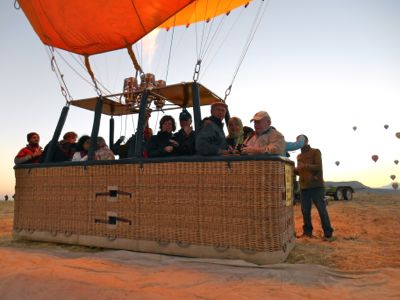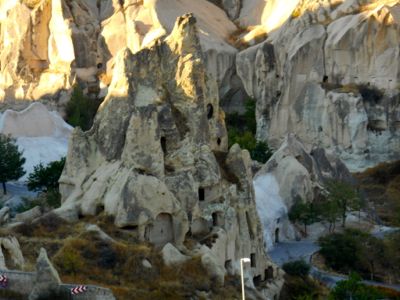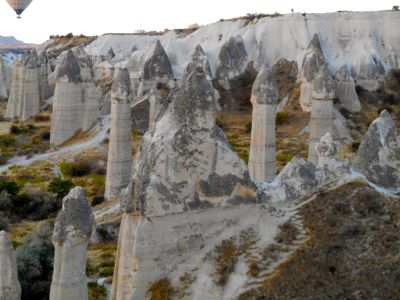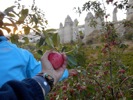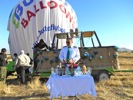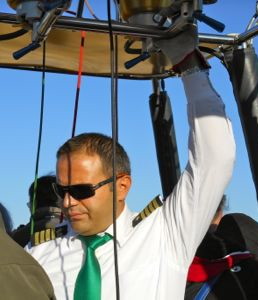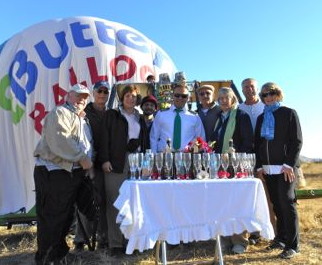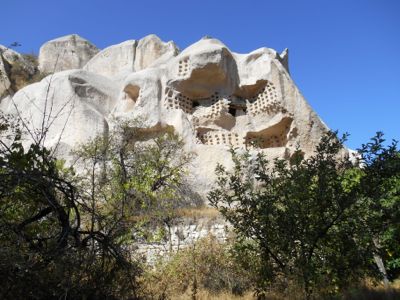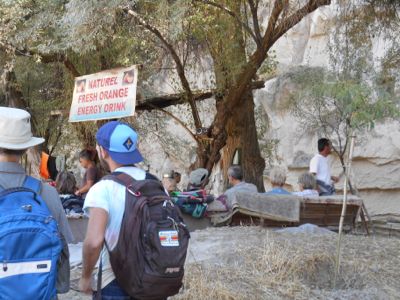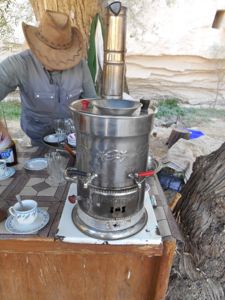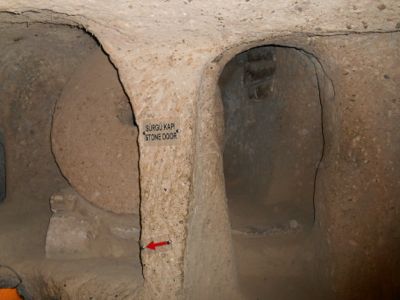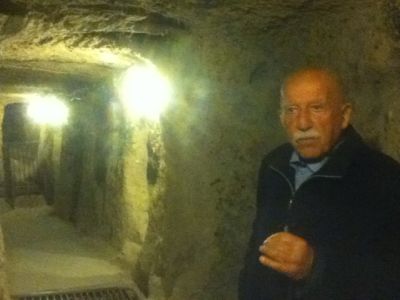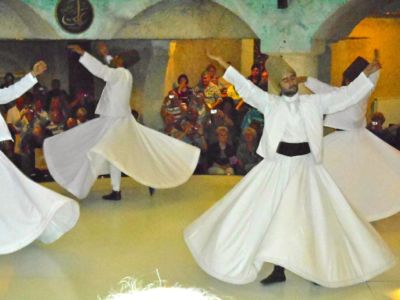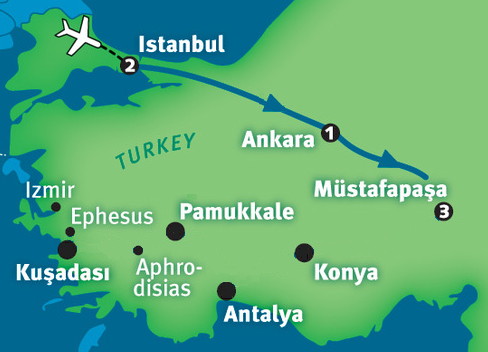Day 6 - Cappadocia
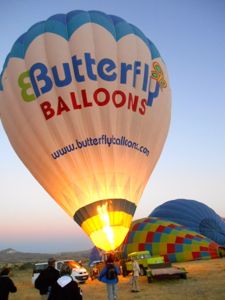 One of the highlights of the tour was an early morning balloon ride[*].
I am not a morning person, but it was definitely worth
getting up for our 5:15am(!) pickup.
It was spectacular watching the sunrise and seeing about a hundred other balloons
in the sky.
One of the highlights of the tour was an early morning balloon ride[*].
I am not a morning person, but it was definitely worth
getting up for our 5:15am(!) pickup.
It was spectacular watching the sunrise and seeing about a hundred other balloons
in the sky.Even though I'd never been in a balloon before, I could tell that Mustafa was an excellent pilot. His control over the balloon was amazing!
Pigeon Valley Hike
After returning for a good breakfast (I was pretty hungry by this time, since I got up so early), we headed out for a hike through Pigeon Valley.
These are some of the "pigeon condos" which help give the valley its name. "Pigeon condos? Did pigeons build these?" No, the "condos" are manmade. It turns out pigeon droppings make very good fertilizer. These were carved out so that farmers could collect the droppings more easily.
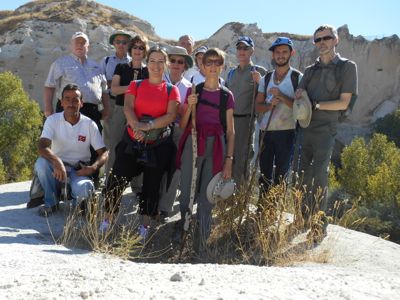
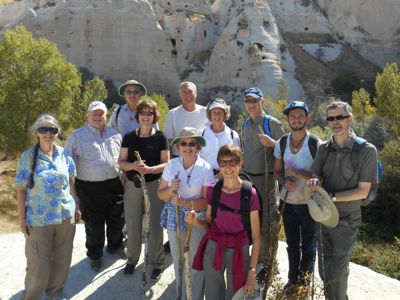
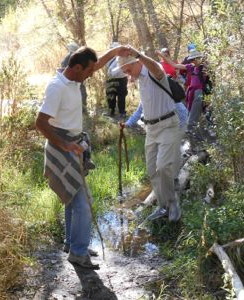
And the most amazing thing of all: right out in the middle of nowhere, a coffee and juice stand! We had probably hiked about two kilometers, with another one to go before we got to a road, and here it was. They had a little ATV which they used to carry supplies in. It was amazing, and a much needed rest break. (It was getting pretty hot by that time of day.)
Kaymakli Underground City
People have been living underground since at least the 4th century BC. They could remain there (with their animals) for as long as three months at a time, but they did not live there permanently. They moved underground to hide from their enemies.
Finally, it was time to visit one of the underground cities. This is what I most wanted to see and what inspired my trip to Turkey. From the first time I read about them, I was fascinated by the idea of people living entirely underground for long periods of time.
Kaymakli[*]
is a large collection of interconnected rooms. It has eight different levels, but only the top four were open for touring.
We saw the stables (upper level, near the entrance), a cooking area (with ventilation to the outside), storage rooms, and several living areas.
What I learned:
There are tunnels connecting different towns, so people didn't even have to come above ground to get to a neighbor.
There are several ventilation shafts to keep the air fresh and wells to provide water.
One thing reminded me of the "Indiana Jones" movies: the entrances have huge stone slabs which can be rolled across to block the opening.
Dervish Ceremony
The day's activities concluded with a visit to a Dervish[*] ceremony (another optional activity). This was a re-creation of a religious ceremony[*], but shortened for tourists. Since it was a religious ceremony, no photography was allowed. However, after it was over, they came back out and did a few twirls for the cameras.
What I learned:The Dervishes are one branch of Sufism. Sufis are followers of Rumi (also known as Mevlana), an Islamic mystical poet. The ceremony consists of several distinct parts, but not all involve whirling. While whirling, the Dervish has his right hand facing up, toward the sky, and his left facing down toward the earth. His eyes are focused on the left hand. One foot remains stationary, forming a pivot point.
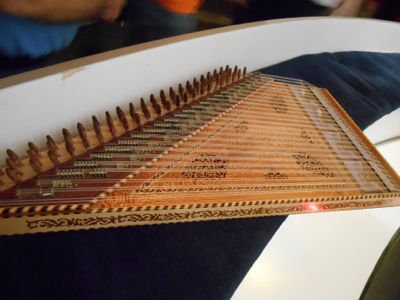 The music was in turns exciting and mesmerizing.
The instruments were all different from anything I had seen before.
This one is a Kanun[*]
(or Qanon in other places). The man playing it was a real virtuoso. I liked it so much that I
bought a CD (later in the trip and not him, but someone else also very good - they didn't have one for sale at the ceremony).
The music was in turns exciting and mesmerizing.
The instruments were all different from anything I had seen before.
This one is a Kanun[*]
(or Qanon in other places). The man playing it was a real virtuoso. I liked it so much that I
bought a CD (later in the trip and not him, but someone else also very good - they didn't have one for sale at the ceremony).
"hadi gidelim"
let's go



 I would have liked to see more of the underground cities, but I was the minority. I'll have to go back some time.
I would have liked to see more of the underground cities, but I was the minority. I'll have to go back some time.

